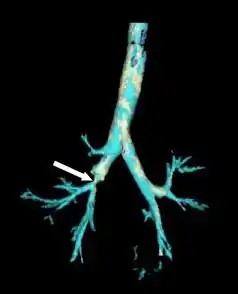Stenosis
Stenosis (from Ancient Greek στενός, "narrow") is the abnormal narrowing of a blood vessel or other tubular organ or structure such as foramina and canals. It is also sometimes called a stricture (as in urethral stricture).[3]
| Stenosis | |
|---|---|
| Other names | Stenoses |
 | |
| CT scan of a bronchial stenosis (arrow) that resulted from tracheobronchial injury | |
| Pronunciation | |
Stricture as a term is usually used when narrowing is caused by contraction of smooth muscle (e.g. achalasia, prinzmetal angina); stenosis is usually used when narrowing is caused by lesion that reduces the space of lumen (e.g. atherosclerosis).[4] The term coarctation is another synonym,[5] but is commonly used only in the context of aortic coarctation.[6][7]
Restenosis is the recurrence of stenosis after a procedure.[8]
Examples
Examples of vascular stenotic lesions include:
- Intermittent claudication (peripheral artery stenosis)
- Angina (coronary artery stenosis)
- Carotid artery stenosis which predispose to (strokes and transient ischaemic episodes)[9]
- Renal artery stenosis
Types
In heart valves
The types of stenoses in heart valves are:
- Pulmonary valve stenosis, which is the thickening of the pulmonary valve, therefore causing narrowing
- Mitral valve stenosis, which is the thickening of the mitral valve (of the left heart), therefore causing narrowing
- Tricuspid valve stenosis, which is the thickening of the tricuspid valve (of the right heart), therefore causing narrowing
- Aortic valve stenosis, which is the thickening of the aortic valve, therefore causing narrowing
Elsewhere
Stenoses/strictures of other bodily structures/organs include:
- Pyloric stenosis (gastric outflow obstruction)
- Lumbar, cervical or thoracic spinal stenosis
- Subglottic stenosis (SGS)
- Tracheal stenosis
- Obstructive jaundice (biliary tract stenosis)
- Bowel obstruction
- Phimosis
- Non-communicating hydrocephalus due to aqueductal stenosis
- Stenosing tenosynovitis
- Atherosclerosis
- Esophageal stricture
- Achalasia
- Prinzmetal angina
- Vaginal stenosis
- Meatal stenosis
Causes
Diagnosis
Stenoses of the vascular type are often associated with unusual blood sounds resulting from turbulent flow over the narrowed blood vessel. This sound can be made audible by a stethoscope, but diagnosis is generally made or confirmed with some form of medical imaging (such as ultrasound).[10]
See also
References
- OED 2nd edition, 1989, as /stɪˈnəʊsɪs/.
- "Definition of STENOSIS". www.merriam-webster.com. Retrieved 2023-02-16.
- "Dorlands Medical Dictionary:stenosis". www.mercksource.com. Retrieved 2010-05-05.
- "What Is Atherosclerosis? - NHLBI, NIH". www.nhlbi.nih.gov. 22 June 2016. Retrieved 1 July 2021.
- "coarctation" at Dorland's Medical Dictionary
- "Coarctation of the Aorta (CoA)". heart.org.
- Groenemeijer, BE; Bakker, A; Slis, HW; Waalewijn, RA; Heijmen, RH (2008). "An unexpected finding late after repair of coarctation of the aorta". Netherlands Heart Journal. 16 (7–8): 260–3. doi:10.1007/bf03086158. PMC 2516290. PMID 18711614.
- Forgos, Richard N. (August 2004). "Restenosis After Angioplasty and Stenting".
- "Carotid Artery Stenosis". The Lecturio Medical Concept Library. 15 March 2021. Retrieved 6 July 2021.
- “Ultrasound diagnosis of carotid artery stenosis and occlusion”, Hidehiro Takekawa et al. Journal of Medical Ultrasonography (2001), pubmed.com
External links
- "Tracheal Stenosis Audio and Video". Archived from the original on 2007-01-12.
- "Symptoms of Urethral Stricture". 20 May 2011. Archived from the original on July 17, 2016.